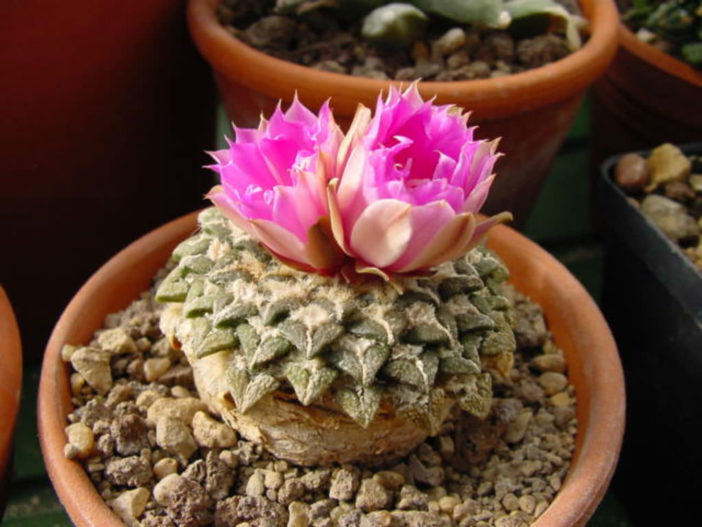Scientific Name
Ariocarpus kotschoubeyanus (Lem.) K.Schum.
Common Name(s)
Star Rock, Living Rock
Synonym(s)
Anhalonium fissipedum, Anhalonium kotschoubeyanum, Anhalonium kotschubeyanum, Roseocactus kotschoubeyanus, Stromatocactus kotschoubeyi
Scientific Classification
Family: Cactaceae
Subfamily: Cactoideae
Tribe: Cacteae
Genus: Ariocarpus
Description
Ariocarpus kotschoubeyanus is a small geophytic cactus with a flat-topped, dark olive green stem with deltoid tubercles with an off-white stripe of hair down the middle. The stem slowly grows up to 3 inches (7.5 cm) in diameter, usually solitary, or rarely, if ever, produces a few offsets to form a small clump. Flowers are nearly white or shell pink to bright magenta and appear from a wooly crown in fall. They are up to 1 inch (2.5 cm) long and 2 inches (5 cm) in diameter. Fruits are white or green with lots of tiny black seeds.
Origin
Ariocarpus kotschoubeyanus is native to northeastern Mexico. It occurs in and around the edges of the Chihuahuan Desert, from Coahuila through Nuevo León, Tamaulipas, Zacatecas, and San Luis Potosí, to Querétaro.
Etymology
The specific epithet "kotschoubeyanus (kot-shoo-bee-AY-nus)" honors Prince Kotschoubey, a Russian prince and patron of horticulture.

Hardiness
USDA hardiness zones 9a to 11b: from 20 °F (−6.7 °C) to 50 °F (+10 °C).
How to Grow and Care
You should plant your Ariocarpus in soil specifically formulated for cacti. You can buy a cactus mix at your local nursery. Do not use generic soil mixes because they will not provide enough aeration and drainage. Additionally, using a container without a hole, whether a pot or a terrarium, is a bad idea for the same reason.
Ariocarpus need a lot of sunlight. However, in hot, dry areas, they can be damaged by excessive sunlight, so you should use a shade cloth to limit their sun or move them out of it during the hottest hours of the day. In more temperate areas, direct sunlight is fine.
These cacti prefer to be kept at room temperature or slightly lower and in low humidity.
Water your Ariocarpus when it is dry, but then wait until the soil dries out completely to water it again. The amount of time this takes will vary depending on your climate and the size of your pot if you use one.
See more at: How to Grow and Care for Ariocarpus.
Links
- Back to genus Ariocarpus
- Succupedia: Browse succulents by Scientific Name, Common Name, Genus, Family, USDA Hardiness Zone, Origin, or cacti by Genus
Photo Gallery
Click on a photo to see a larger version.


